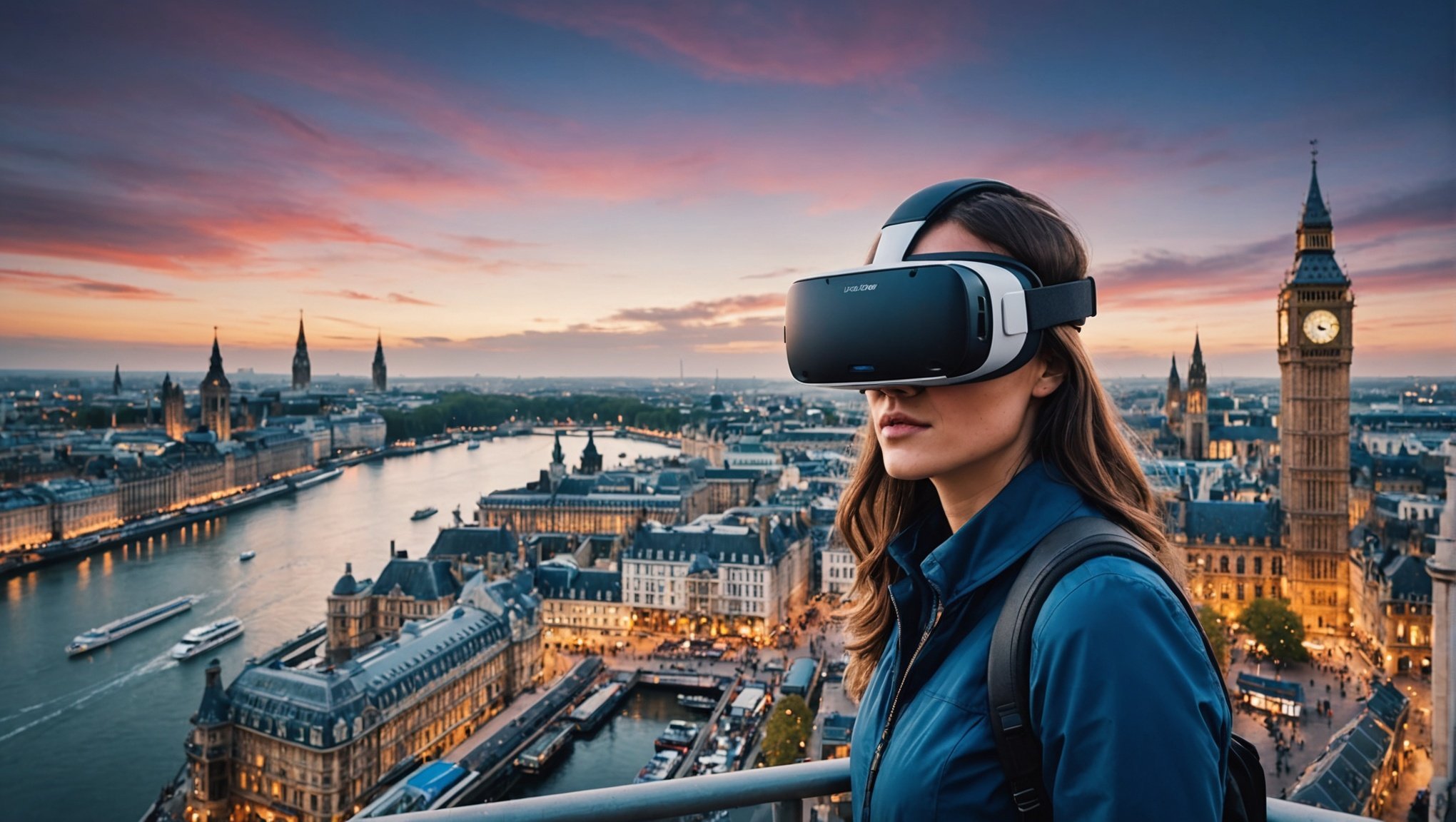The Role of Virtual Reality in Destination Marketing
Virtual Reality (VR) is revolutionising the field of destination marketing, offering new avenues for engaging potential travellers. By creating immersive experiences, destination marketers can transport individuals to their locales without them leaving their seat. This has particularly captivated the UK Tourism Boards, which are integrating VR into their promotional strategies.
Overview of Virtual Reality Technology in Tourism
Virtual Reality technology provides a 360-degree experience, allowing users to explore new destinations in a highly interactive and engaging manner. This technology is leveraged by tourism boards and businesses to provide realistic previews of destinations, boosting interest and desire to visit in person.
Also read : Leveraging Influencer Marketing: A Strategic Guide for UK Tourism Boards to Captivate New Visitors
Importance of Immersive Experiences for Engagement
Immersive experiences created through Virtual Reality play a crucial role in capturing the interest of potential tourists. These experiences provide a sense of presence and engagement, which is unparalleled by traditional marketing methods. This heightened level of interaction encourages deeper emotional connections with destinations, increasing the likelihood of actual travel bookings.
Trends in Consumer Behaviour Regarding Virtual Travel Experiences
Recent trends indicate a growing consumer interest in virtual travel experiences, particularly among the younger, tech-savvy demographic. Consumers appreciate the convenience and accessibility of VR, which allows them to explore destinations at their own pace. This trend has prompted the UK Tourism Boards to adopt VR as a staple in their marketing toolkit, appealing to both domestic and international travelers.
Also to read : Vallourec smart tubular solutions: shaping sustainable energy
Successful Case Studies of VR in UK Tourism
In the realm of UK tourism, virtual reality campaigns have become transformative tools, offering immersive experiences that captivate global audiences.
Notable Implementation in Destination Marketing
An outstanding example includes the use of case studies to showcase the potential of VR. Numerous UK tourist attractions, like historic castles and modern museums, have employed VR to enhance their appeal, allowing virtual tours that display their grandeur and history to a worldwide audience from the comfort of a viewer’s home. This strategic implementation significantly expands outreach and piques potential visitors’ curiosity.
Analysis of Visitor Engagement Metrics
Understanding the impact of these VR campaigns involves an analysis of visitor engagement metrics. Data indicates an increase in interest and consideration, as engagement rates soared where VR was used effectively. Views, shares, and interactions with virtual content directly correlate to heightened interest and subsequent bookings, demonstrating the power of immersive marketing.
Lessons Learned from Successful Campaigns
Successful campaigns have shown a noticeable impact on visitor interest and booking rates. Reviewing these case studies provides invaluable insights, guiding future VR strategies. The comprehensive data collection and analysis post-campaign allow tourism professionals to refine their approaches, proving VR’s role is not just a fleeting trend but a strategic necessity in modern tourism.
Practical Applications of VR for UK Tourism Boards
Tourism boards across the UK are actively harnessing the capabilities of VR experiences to revolutionise their tourism strategies. These transformative technologies offer numerous practical applications that are setting new standards in the industry.
A significant application is the creation of virtual tours of historical landmarks and attractions. This allows potential visitors to explore iconic sites from the comfort of their homes, offering a sneak peek into what they can expect during their physical visit. This immersive experience can ignite interest and encourage bookings.
Incorporating VR into travel planning tools is becoming increasingly common. Tourists can now virtually navigate a destination, making informed decisions about their itineraries and accommodations. Such interaction helps visitors tailor their experience to their preferences, enhancing satisfaction.
Moreover, VR is a powerful asset in promotional materials and online marketing. Tourism boards are leveraging this technology to produce captivating content that captures the essence and allure of a destination. Virtual reality provides a more engaging way to showcase destinations compared to traditional brochures or static images, thus reaching a broader audience and increasing promotional effectiveness.
Benefits of Using VR in Tourism Marketing
Virtual Reality (VR) is revolutionising the way tourism marketers approach consumers. One major benefit is enhancing the sensory engagement of potential visitors. By immersing them in a virtual environment, VR allows users to experience a destination’s sights and sounds long before their actual visit. This interactive preview captivates the senses more effectively than traditional images or videos.
Moreover, VR can significantly improve destination recall and attraction familiarity. Immersive experiences help viewers remember unique aspects of a location, prompting them to choose it over competing options. When users can virtually walk through a heritage site or explore new attractions firsthand, they build a stronger memory of that location.
Additionally, VR fosters emotional connections through immersive storytelling. By placing viewers inside authentic narratives, tourism marketers can evoke emotions that align with the destination’s unique qualities. This emotional engagement increases the likelihood of users acting upon these feelings, driving their decision to visit.
These benefits collectively enhance any marketing strategy. Incorporating VR into campaigns ensures a memorable and engaging promotional effort that speaks directly to the viewer’s desires and emotions. As a result, VR is becoming an indispensable tool in the fast-evolving landscape of tourism marketing.
Challenges in Implementing VR Solutions
The integration of VR technology into tourism marketing presents several challenges. One major hurdle is the high costs associated with both the technology itself and the production of VR content. These expenses can be prohibitive for smaller tourism boards or businesses, limiting access to those with substantial budgets.
Additionally, there are substantial technical barriers that might affect both providers and tourists engaging with VR. Ensuring that technology is accessible to a diverse audience means overcoming issues such as hardware compatibility, user interface design, and the need for robust internet connections. Many tourists may not own the latest devices capable of supporting high-quality VR experiences, which can lead to frustration and decreased engagement.
Finally, keeping VR content relevant and updated poses another significant challenge. As destinations evolve and tourist trends shift, content can quickly become outdated or irrelevant. This necessitates a continuous investment in content curation and development to maintain tourists’ interest and ensure that experiences are both engaging and reflective of current offerings. Failure to address these challenges may lead to tourist disinterest, undermining the intended impact of VR in the tourism industry.
Future Trends in VR and Destination Marketing
As industries embrace innovation, Virtual Reality (VR) is reshaping tourism and marketing strategies. Combining immersive experiences with future trends, VR’s role is becoming pivotal.
Predictions for VR Adoption in the Tourism Sector
VR adoption in tourism is set to expand dramatically. Enhanced VR technology allows potential travelers to explore destinations virtually, matching their expectations by offering realistic previews. This accessibility encourages bookings by reducing uncertainties.
Potential Developments in VR Technology
Ongoing innovation in tourism propels VR technology. We anticipate refined graphics, haptic feedback, and sensory augmentations to create comprehensive experiences. As technology progresses, immersive VR journeys could replicate real-world sensations.
The Role of User-Generated Content in VR Marketing
User-generated content shapes VR marketing. Users can create shareable virtual tours, showcasing personal experiences and inspiring peer travelers. It builds trust, as authentic perspectives highlight destinations beyond corporate standards.
Tour operators must collaborate closely with tech partners to stay ahead with emerging technologies. These alliances ensure seamless integration of VR advancements, guaranteeing traveler satisfaction through continuous evolution. Looking forward, successful destinations will adapt to dynamic traveler expectations, prioritizing personalized, immersive experiences fueled by cutting-edge VR technology.











